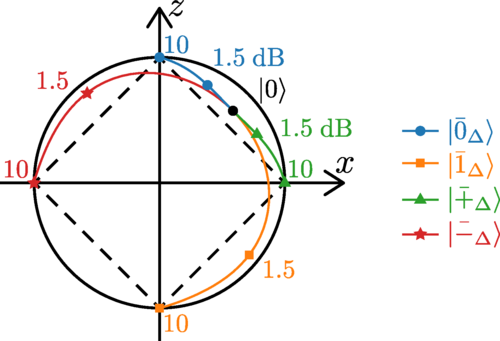The Gottesman-Kitaev-Preskill (GKP) error-correcting code, a method of encoding a finite-dimensional logical space in bosonic modes, has been improved by the stabilizer subsystem decomposition. This new subsystem decomposition resolves several issues with the GKP code and can be used to efficiently simulate noise acting on single-mode GKP codes. The research, conducted by Mackenzie H Shaw, Andrew C Doherty, and Arne L Grimsmo, also found that GKP codes are more resilient against pure loss than against dephasing. The findings were published in February 2024.
What is the Gottesman-Kitaev-Preskill (GKP) Error-Correcting Code?
The Gottesman-Kitaev-Preskill (GKP) error-correcting code is a method of encoding a finite-dimensional logical space in one or more bosonic modes. This code has recently been demonstrated in trapped ions and superconducting microwave cavities. The GKP code is one of the most intensively studied encodings of this type, and the single-mode square GKP qubit code has recently been realized in both trapped ions and superconducting microwave resonators.
From a theoretical perspective, bosonic codes can be understood as defining a logical subspace of the continuous-variable (CV) quantum systems. However, in the case of GKP codes, the non-normalizability of the codewords means that the GKP logical subspace is formally not in the CV Hilbert space. An alternative formulation is to consider a decomposition of the Hilbert space such that the logical information in the error-correcting code forms a subsystem.
What is the Stabilizer Subsystem Decomposition?
The stabilizer subsystem decomposition is a new subsystem decomposition for GKP codes. This decomposition has the defining property that a partial trace over the non-logical stabilizer subsystem is equivalent to an ideal decoding of the logical state. This decomposition is also of practical use as it can be used to efficiently simulate noise acting on single-mode GKP codes.
The stabilizer subsystem decomposition can be applied to all multimode qubit or qudit GKP codes, including the concatenation of GKP and qubit stabilizer codes. For any GKP encoding, it is possible to write an arbitrary CV state in the corresponding stabilizer subsystem decomposition from the position wave function of the state.
How Does the Stabilizer Subsystem Decomposition Improve the GKP Code?
The stabilizer subsystem decomposition resolves several issues with the GKP code. It has the desirable property that tracing over the non-logical subsystem corresponds to a noiseless decoding map for the GKP code. This decomposition is entirely analogous to the stabilizer-destabilizer formalism of qubit codes.
One practical challenge with GKP codes is the difficulty of numerically simulating GKP codes using a truncated Fock basis. Using the stabilizer subsystem decomposition, it is possible to study realistic noise channels such as loss and white-noise dephasing for essentially arbitrary photon numbers.
What are the Practical Applications of the Stabilizer Subsystem Decomposition?
The stabilizer subsystem decomposition is not only of theoretical interest but also has practical applications. It can be used to efficiently simulate noise acting on single-mode GKP codes. In contrast to more conventional Fock basis simulations, it is possible to consider essentially arbitrarily large photon numbers for realistic noise channels such as loss and dephasing.
In the case of the single-mode square GKP qubit code, the treatment is analytical. It was found that GKP codes are far more resilient against pure loss than against dephasing. A square single-mode code state with ten decibels of GKP squeezing achieves an average gate infidelity below 10^-3 for a loss rate of 10^-4 per gate.
Publication details: “Stabilizer Subsystem Decompositions for Single- and Multimode Gottesman-Kitaev-Preskill Codes”
Publication Date: 2024-02-23
Authors: Mackenzie H. Shaw, Andrew C. Doherty and Arne L. Grimsmo
Source: PRX Quantum 5, 010331
DOI: https://doi.org/10.1103/PRXQuantum.5.010331

